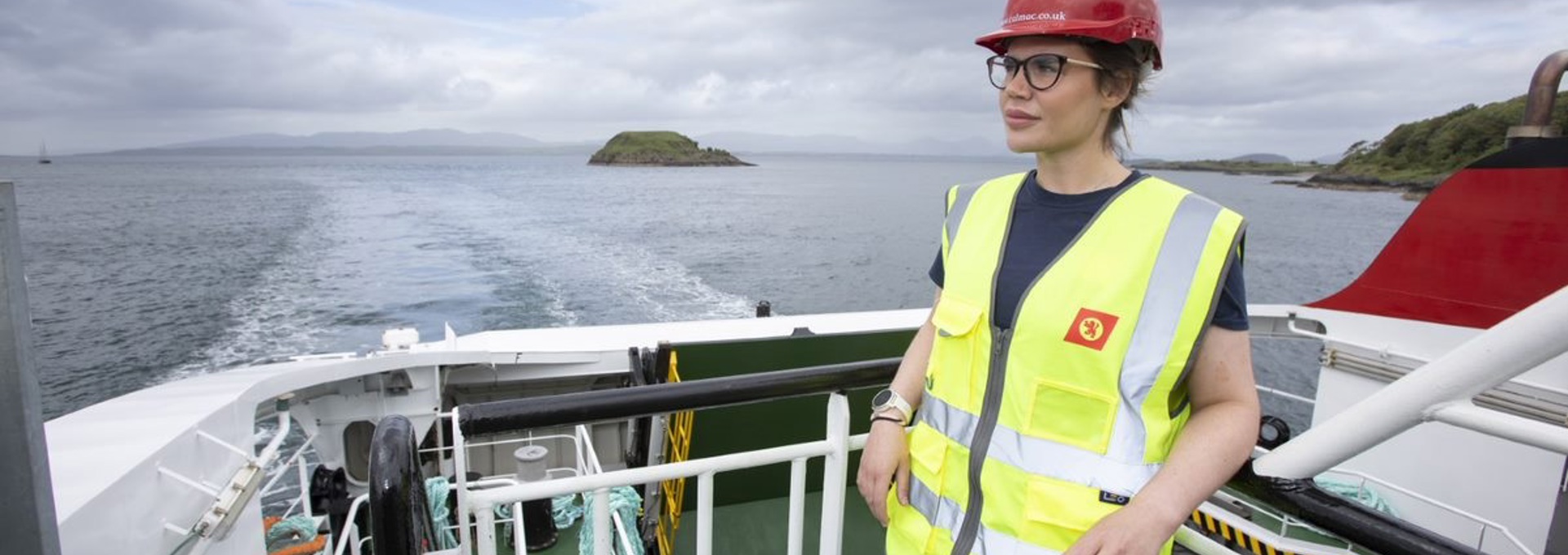Work with us
If you’re looking for an exciting career, with a company that values teamwork, inclusion, and initiative then join our team.
Current vacanciesCaledonian MacBrayne has a history that stretches back more than 170 years. Our name is synonymous with the west coast of Scotland, providing vital lifeline ferry services and carrying millions of people each year to and from the islands and remote peninsular communities. We have been, and remain, a major local employer both on shore and at sea. This short history summarises the key milestones from our inception in the 1850s to the modern, award-winning operator we are today.

Caledonian MacBrayne has a history that stretches back more than 170 years. Our name is synonymous with the west coast of Scotland, providing vital lifeline ferry services and carrying millions of people each year to and from the islands and remote peninsular communities. We have been, and remain, a major local employer both on shore and at sea. This short history summarises the key milestones from our inception in the 1850s to the modern, award-winning operator we are today.
Caledonian MacBrayne started life in 1851 as a steamer company under the name of David Hutcheson & Co. The main sphere of operation was from Glasgow through the Crinan Canal to Oban and Fort William and then on through the Caledonian Canal to Inverness.
In the late 1870s, the Hutcheson brothers retired leaving the firm in the hands of David MacBrayne to which the firm was renamed. Throughout the late 1870s and 1880s the MacBrayne empire continued to expand with a mail run to Islay, Harris and North Uist from Skye and an Outer Isles run from Oban to Barra and South Uist.
In quick succession, new railways began to reach the west coast at Fort William, Kyle of Lochalsh and Mallaig, and the fleet rosters were altered to meet the new situation. There followed a period of new ship building, largely for the mail routes to the islands and remote mainland communities.
Following World War I, David MacBrayne was operating a much-reduced fleet. This eventually resulted in the company's withdrawal from the tender for the mail contract. Thanks to a rescue operation jointly with LMS Railway and Coast Lines Ltd. a new company was formed – David MacBrayne (1928).
1948 saw the nationalisation of the LMS shares in the company and the acquisition of the ships. Five years later the state-owned Scottish Transport Group (STG) was formed to operate not only David MacBrayne's services, but also those of the Caledonian Steam Packet Company (CSP) on the Clyde together with the dominant Scottish Bus Company.
Soon after, the shipping companies were amalgamated and renamed Caledonian MacBrayne Ltd.; lorry services were operated by MacBrayne Haulage, while David MacBrayne was retained for certain minor services. The Caledonian MacBrayne vessels soon sported the red CSP lion in a yellow disc in the centre of the red funnel.
In 1990, Caledonian MacBrayne became wholly owned by the Secretary of State for Scotland (now the Scottish Government).
In 2006, the Scottish Executive decided that under EU rules ferry services were required to be put out to tender. This presented an issue, as the vessels required to operate the services and many of the ports to which services ran were owned by Caledonian MacBrayne Ltd., giving it an unfair advantage over potential competitors.
The solution was to rename Caledonian MacBrayne Ltd. as Caledonian Maritime Assets Ltd. (CMAL) so that vessels and ports would be retained in state ownership, while a separate ferry operations company, CalMac Ferries Ltd. (CFL), was created. CFL is a wholly-owned subsidiary of David MacBrayne Ltd., which is wholly owned by Scottish Ministers. CMAL also retained ownership of the Caledonian MacBrayne brand, which CFL uses as a trading name under licence from CMAL. The lion rampant device is also used by CFL with the permission of CMAL.
In 2007, the contract to provide services under the Clyde and Hebrides Ferry Service (CHFS) was awarded to CFL for six years. CMAL leases the vessels and piers to the operator of the CHFS (currently CFL) and is also responsible for the procurement of new ships and the maintenance and development of port facilities in its ownership. Some ports are owned by local authorities or private harbour trusts/authorities.
In 2013, Transport Scotland, which is part of Scottish Government, extended the CHFS contract by a further three years, to be put out to tender for a new contract to commence in October 2016. In May 2016, it was confirmed that the bid submitted by CFL had been successful and a six-year contract – with the option of a two-year extension – was awarded by Transport Scotland.
In December 2017, Transport Scotland published an interim report into its Ferry Services Procurement Policy Review and Mr Yousaf MSP made a statement to Parliament advising that it was the Government's desire not to put the next CHFS contract out to tender in 2024. It believed that, with some minor changes to the constitution of David MacBrayne Ltd., the contract could be awarded directly to an in-house provider, such as CFL, if it was compliant with the Teckal Exemption and EU state aid rules.
In November 2023, Minister for Transport Fiona Hyslop made a statement about the future of the Clyde and Hebrides Ferry Service (CHFS) contract, confirming the intention to explore a direct award to CalMac for the next CHFS contract.

If you’re looking for an exciting career, with a company that values teamwork, inclusion, and initiative then join our team.
Current vacancies